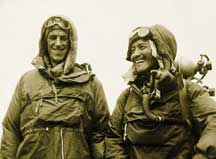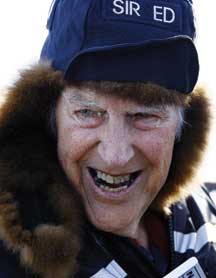Arts
Scaling Summits

Decades after Hillary's success, commercialism - and courage - fill the Himalayas
|
Fifty years later, the man who first stood on the roof of the world lamented how Mount Everest had changed since his historic summit. “It is hardly mountaineering; more like a conducted tour,” Sir Edmund Hillary told reporters in Katmandu in 2003, celebrating the anniversary of his and Sherpa Tenzing Norgay’s historic 1953 climb of the 8,849.8-meter (29,035-foot) summit. “Commercial climbing has developed, with many inexperienced enthusiasts, dozens of aluminum ladders, thousands of meters of fixed rope,” he said. Hillary, a lanky New Zealand beekeeper who became one of the 20th century’s most famous explorers, died Jan. 11 of a heart attack at age 88. He lived long enough to see the Himalayas, once an impossibly isolated region, become a popular destination for anyone with the tens of thousands of dollars it costs to join a commercial expedition to the highest peaks. “I think the whole attitude toward climbing Mount Everest has become rather horrifying. The people just want to get to the top,” he told a newspaper in New Zealand in 2006, after a young British mountaineer died high on Everest after dozens of climbers passed by him and did nothing to help.
It was different in Hillary’s day. “Hillary was lucky enough to live at a time when Everest was still unconquered,” said Italian mountaineer Reinhold Messner from Bolzano, Italy, in the mountainous South Tirol region. Messner, who soloed Everest in 1980 without supplemental bottled oxygen and became the first person to climb the world’s 14 peaks that are higher than 8,000 meters (yards), lauded Hillary as a man who had “the courage to dare.” Today, he said, mountaineers “have better equipment, we know almost everything, we can even make calls with a satellite phone from Everest’s peak.” But if wealthy dilettantes on commercial expeditions are a modern mountaineering cliche, and thefts increasingly common in crowded Himalayan base camps and even in some climbers’ camps higher above, the serious alpinists are still there. It’s just that, very often, they’re no longer on Everest. “The joy of adventure has been taken away” on Everest, said retired Indian army colonel Narender Kumar, 74, who missed the summit by 200 meters (yards) in 1960. With lighter gear, high-tech equipment and fabrics, more knowledge of the areas, better physical training and reliable bottled oxygen, the frontiers of climbing can be pushed today far beyond what was done in Hillary’s time. “Things that we thought were impossible are being done,” Kumar said. These days, the greatest challenges are often more complex than simply reaching the top. A small circle of serious high-altitude alpinists try going in winter, or solo, or in fast and light teams of two. From the Himalayas to the Karakoram to Patagonia, some are pushing the limits of difficult rock and ice climbing at higher altitudes. The climbing philosophy that Messner pushed – using “fair means,” with no porters and little other backup support, and using no bottled oxygen or ladders to cross crevasses – has become the guiding philosophy to a new generation of mountaineers. The stories that grip climbers in those circles are of a Russian team that summited a brutal unclimbed face of the world’s second-highest peak, K2, stopping only to rescue teammates hit by altitude sickness; a Slovenian who soloed the south face of Annapurna; the Americans who pioneered a new route up Nanga Parbat’s giant Rupal Face, first climbed by Messner; the Russian-American trying to make the first solo winter ascent of Mount McKinley, North America’s highest peak. There are still many challenges out there, including some high unclimbed peaks and forbidding mountain faces in China and India. “People are taking chances with difficult expeditions we couldn’t even imagine,” Kumar said.
Some mountaineers have also tried to follow Hillary’s example by becoming conservationists or working on behalf of the often desperately poor Himalayan villagers who live in the shadow of the highest mountains. In Katmandu a small group gathered on the lawn of the Nepal Mountaineering Association’s Katmandu headquarters to remember Hillary and what he’d done here – from his summit of Everest to the schools, hospitals and clinics he’d helped fund and build for Sherpa villages. Ang Rita, who heads the Himalayan Trust, the group Hillary founded in 1962 to help develop the region around Everest, said Hillary’s schools helped thousands of people. “He helped the Sherpa people with education and health, and is responsible for whatever development that has happened in the area,” he said as the sun fell and the Himalayan cold began to bite. “People may remember him as the conqueror of Everest, but I think he would like to be remembered for the work he did for the Sherpa people.” |



You must be logged in to post a comment Login